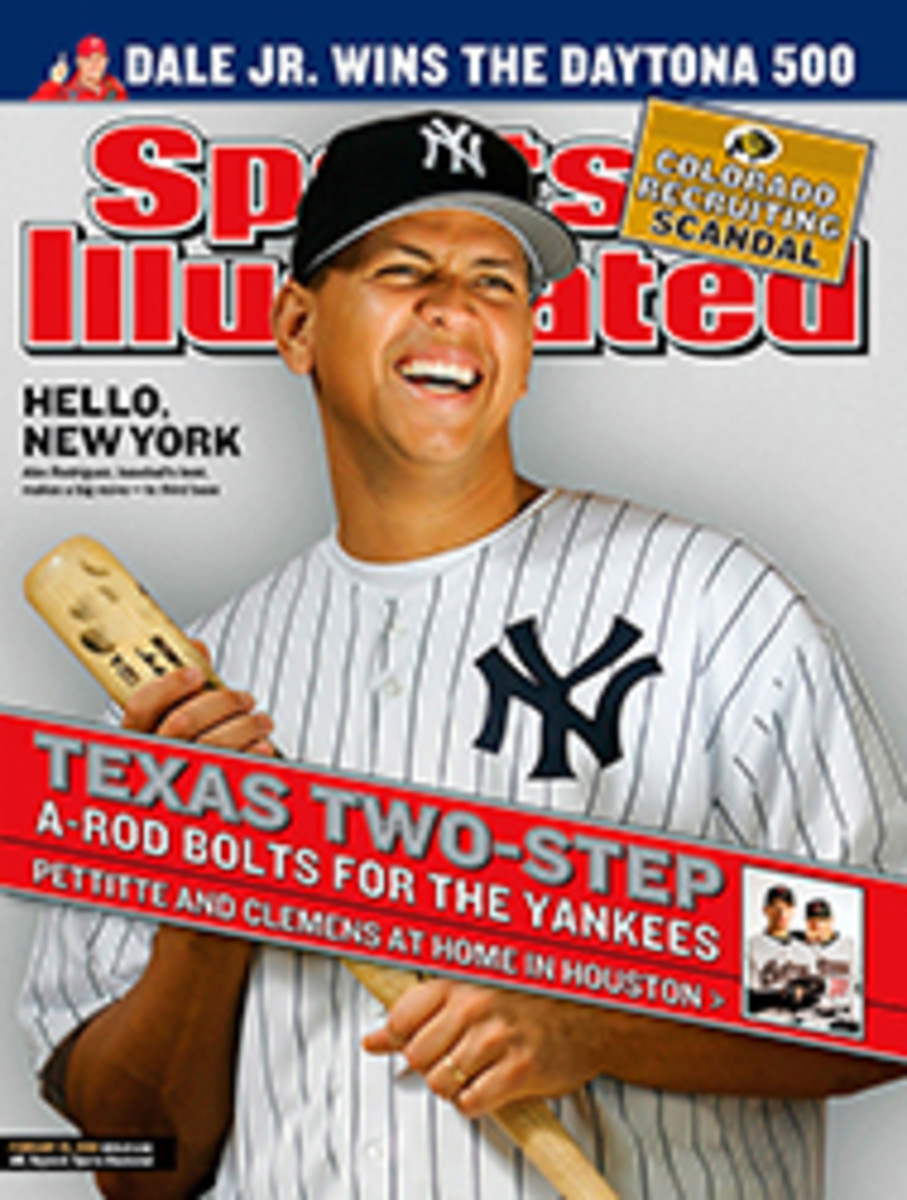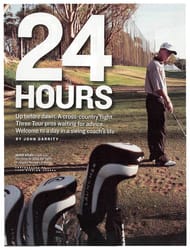
Play Ball! The reporting of pitchers and catchers is a sign that spring is near, and nobody does spring training like the folks at Dodgertown
It is a myth that time stands still at Dodgertown. Many years have
passed, for instance, since a Dodgers player last ate mess hall
grub off a Navy-issued, trisected metal serving tray or climbed
trees to avoid the night watchman enforcing curfew.
At the team's spring training camp in Vero Beach, Fla., however,
time does mosey. It flutters like a soft breeze through the
azaleas, palmettos, royal palms and scrub pines in a baseball
training facility disguised as an arboretum. With Dodgertown, as
with the Acropolis or Sophia Loren, time slows its usual advance
when under the spell of archetypal beauty.
"If you don't like Dodgertown," says the team's traveling
secretary, Bill DeLury, who is in his 38th spring there, "you
don't like peanut butter. It's ... it's ... un-American."
When the ball club isn't there, Dodgertown is also a sports and
conference center, so you, too, can bunk where players have for
more than half a century. ("Ron Washington Slept Here.") To hook
you, the Dodgertown website brags about "world-class recreation
facilities, including ... horseshoes." Horseshoes? Did we mention
canasta?
Forget Punxsutawney Phil. Pitchers and catchers reporting is the
most reliable sign that winter is yielding its icy grip. This
week marks the start of our annual renewal of light and soul. A
dozen teams begin training in Arizona, most of them in fabulously
modern facilities in the Phoenix and Tucson areas. Florida, with
its 18 teams spread throughout a home-plate-shaped area with a
677-mile perimeter, is the Greek-diner menu of spring training.
It has a little of everything.
Almost 1.4 million fans watched spring training games last year
at Florida's 17 camps. (The Florida Marlins and the St. Louis
Cardinals share a site.) That does not include the thousands who
showed up for workouts to watch the always exciting
pitchers-covering-first-base drill.
Spring training in Florida is believed to have started in 1888,
when the Washington Senators repaired to Jacksonville for three
weeks of camp. Connie Mack, foreshadowing the blurred line
between spring training and spring break, once recalled of his
days as a catcher, "We played exhibitions during the day and
drank most of the night."
The most popular destination is Tampa, where the New York Yankees
draw almost as many fans for games that don't count as the
Montreal Expos do for regular-season games. The Yankees' Legends
Field is a fine facility, as long as your idea of spring training
repose is fighting New York-mannered crowds and security while
sucking down the exhaust of six-lane traffic on Dale Mabry
Highway.
Truth is, if you want real spring training, you go to Dodgertown,
otherwise known simply as Vero or colloquially as "the base."
Indeed, the tract served as a U.S. Naval air base before the
Dodgers moved their spring headquarters there from Havana, Cuba,
in 1948. Moving to the Florida site allowed Branch Rickey, the
father of the modern farm system, to train all of the
organization's players in the same complex. (Rickey also wanted a
facility in the segregated South in which his black players would
be housed and fed with their white teammates.)
More than 600 players moved into what were built as temporary
barracks for servicemen and included wood-plank flooring and
three bunk beds to a room. Dodgers of the '50s and '60s were
awakened at six each morning by a shrill whistle, hustled to the
mess hall to eat breakfast off their metal trays, then drilled on
fundamentals all day. In Vero, for instance, Rickey installed his
famous "strings"--the strike zone outlined in string in front of
home plate--which allowed pitchers to work on their control.
For diversions Dodgers owner Walter O'Malley made available
Ping-Pong tables, pinball, a nine-hole executive golf course and
later a full 18-hole track and basketball and tennis courts.
Wives of players and front-office employees sunned at the pool.
Movies were shown three times a week.
"I never have to leave the base," says former manager Tommy
Lasorda, who, having first arrived at Vero in 1949 as a minor
league pitcher, has logged more time in Dodgertown than any other
Dodger. "And the food is not pretty good. It's real good."
Of course in decades past players did venture off base for
diversions that sometimes kept them out past curfew. In 1961
manager Walter Alston heard Sandy Koufax and fellow pitcher Larry
Sherry trying to sneak in past curfew. Alston pounded so hard on
Sherry's door that he cracked the diamonds in his 1955 World
Series ring. On the team bus the next morning Koufax quipped,
"Hey, Larry, had your door appraised for diamonds yet?"
"What makes Dodgertown so special is the campus environment,"
says Peter O'Malley, who succeeded his father as Dodgers
president in 1970 and sold the team in 1998. "It brings everybody
together."
Alas, the big league players haven't stayed on base for years.
They rent expensive condos near the ocean. In 1972 the barracks
were replaced by one-story motel-style accommodations. (The minor
leaguers remain on the base, two to a room.) The lavish press
room where writers would linger to drink, play cards and tell
stories with O'Malley and Rickey has been replaced by a concrete
bunker in a two-year-old administration building that also houses
the spacious major league clubhouse.
Still, walking the meticulously clipped grounds of Dodgertown is
like walking the back nine at Augusta. Over there, behind the old
clubhouse, are six pitching mounds shaded by huge palms. The
strings are still here. So as not to embarrass him in front of
crowds, the Dodgers worked with Koufax here on his early-career
control problem. Newcombe, Drysdale, Podres, Sutton, Hershiser
... they all toiled on these mounds.
Way back there, on fields 5 and 6, minor leaguers swat
batting-practice pitches into the palmettos beyond the outfield
fence. A major league coach rides by on one of the base's many
beach bikes. Fans stroll down Don Drysdale Drive and Vin Scully
Way, streets dotted with baseball-globed lampposts, with only a
yellow rope between them and the ballplayers at work. No other
spring training site offers fans better access.
There is Holman Stadium, the main diamond, where neither the
stands (of which there are only 17 rows) nor the dugouts are
roofed, where orange trees and Southern pines are the centerfield
backdrop for hitters and where two oaks grow smack in the middle
of the stands. A banner hanging over the main entrance to the
complex says, IT'S GREAT TO BE AT DODGERTOWN! And as you pass
under it, through a portal to another world, and you hear the
crack of bats and thumping of leather from all directions, and
you know the dining room will have fresh strawberries and cream,
the theater will screen a movie and the pool is open until
midnight, you must smile in agreement.
The best vantage point, however, may be high above Dodgertown.
From there you see that the man-made lake beside Holman Stadium
is carved in the shape of a heart. It was Walter O'Malley's
valentine to his wife, Kay. The rest of the 300 verdant acres is
a valentine to baseball fans, reminding them what spring training
should be.
For more about sports in Florida and the other 49 states, go to
si.com/50.
COLOR PHOTO: PHOTOGRAPHS BY CHUCK SOLOMON
COLOR PHOTO: PHOTOGRAPHS BY CHUCK SOLOMON MADE IN THE SHADE Trees growing in the middle of the stands at Holman Stadium are among the touches that make Dodgertown unique.
TWO COLOR PHOTOS: PHOTOGRAPHS BY CHUCK SOLOMON SPECIAL EFFECT Peter O'Malley says the campus environment "brings everybody together."
"If you don't like Dodgertown, you don't like peanut butter,"
says DeLury, the team's traveling secretary. "It's ... it's ...
un-American."

